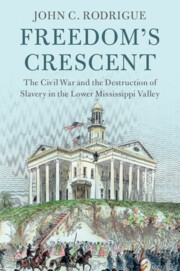Book contents
- Freedom’s Crescent
- Cambridge Studies on the American South
- Freedom’s Crescent
- Copyright page
- Dedication
- Epigraph
- Contents
- Figures
- Acknowledgments
- Abbreviations
- Additional material
- Introduction
- Prologue Life – and Labor – on the Mississippi
- Part I From War for Union to Military Emancipation, 1860–1862
- Part II From Military Emancipation to State Abolition, 1863
- 5 “The Return of the Seceded States to This Union as Slave States”
- 6 “Repugnant to the Spirit of the Age”
- 7 “The Greatest Question Ever Presented to Practical Statesmanship”
- 8 “The Name of ‘Slavery’”
- 9 “Repudiating the Emancipation Proclamation and Reestablishing Slavery”
- Part III Abolition: State and Federal, 1864
- Part IV The Destruction of Slavery, 1865
- Epilogue Memphis and New Orleans: May 1–3 and July 30, 1866
- Bibliography
- Index
5 - “The Return of the Seceded States to This Union as Slave States”
from Part II - From Military Emancipation to State Abolition, 1863
Published online by Cambridge University Press: 19 January 2023
- Freedom’s Crescent
- Cambridge Studies on the American South
- Freedom’s Crescent
- Copyright page
- Dedication
- Epigraph
- Contents
- Figures
- Acknowledgments
- Abbreviations
- Additional material
- Introduction
- Prologue Life – and Labor – on the Mississippi
- Part I From War for Union to Military Emancipation, 1860–1862
- Part II From Military Emancipation to State Abolition, 1863
- 5 “The Return of the Seceded States to This Union as Slave States”
- 6 “Repugnant to the Spirit of the Age”
- 7 “The Greatest Question Ever Presented to Practical Statesmanship”
- 8 “The Name of ‘Slavery’”
- 9 “Repudiating the Emancipation Proclamation and Reestablishing Slavery”
- Part III Abolition: State and Federal, 1864
- Part IV The Destruction of Slavery, 1865
- Epilogue Memphis and New Orleans: May 1–3 and July 30, 1866
- Bibliography
- Index
Summary
Emancipation Proclamation also provides for black military enlistment, and a significant percentage of black Union troops eventually come from the lower Mississippi valley. Proclamation also raises issue of how emancipation will factor into restoring rebellious states, and debate begins in Congress and northern society over securing free-state restoration. Unionist movements in Louisiana and Tennessee begin to divide into “free-state” and “conservative” factions. Free-state Unionists are committed to restoring rebellious states without slavery, though opposing black political and legal equality. Conservative Unionists develop argument for restoring states to the Union while maintaining slavery. Republicans formulate Reconstruction policy around the Constitution’s “republican form of government” in requiring the rebellious states to abolish slavery.
Keywords
- Type
- Chapter
- Information
- Freedom's CrescentThe Civil War and the Destruction of Slavery in the Lower Mississippi Valley, pp. 115 - 131Publisher: Cambridge University PressPrint publication year: 2023

